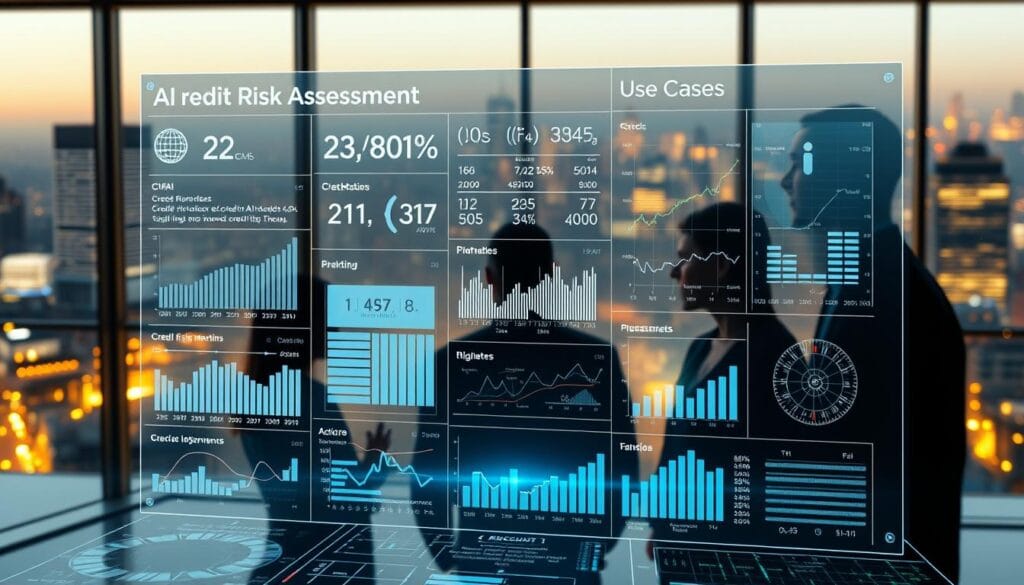The banking sector is undergoing a massive transformation, with artificial intelligence reshaping how financial institutions evaluate borrowers. By 2030, the market for AI in credit risk management is projected to skyrocket from $3.88 billion to $64 billion1. This growth highlights the increasing reliance on advanced technology to streamline lending decisions.
Modern solutions analyze over 40 global data sources, offering deeper insights than traditional methods2. Companies like Chevron Phillips Chemical and Dr Pepper Snapple Group already leverage real-time monitoring and automated workflows, saving millions annually23. The precision of these tools helps lenders minimize defaults while expanding access to credit.
With machine learning detecting subtle behavioral changes, financial institutions gain a competitive edge. Neural Technologies’ ActivML even provides transparent scoring through Explainable AI, ensuring fairness in evaluations1. As adoption grows, these innovations promise faster approvals and smarter risk mitigation.
Key Takeaways
- The AI banking market could reach $64 billion by 20301.
- Machine learning processes 40+ credit data sources for comprehensive analysis2.
- Real-time monitoring helps companies proactively manage financial exposure.
- Automated workflows reduce approval steps, cutting processing time significantly.
- Explainable AI ensures transparent and fair credit scoring decisions.
Introduction to AI in Credit Risk Assessment

Modern lenders harness machine learning to transform credit evaluations. These systems analyze thousands of data points—from payment histories to social media activity—replacing outdated manual processes4.
By 2021, 79% of large banks (with over $100B assets) adopted algorithmic tools for credit risk management4. Adoption grew 200% between 2018 and 2021, reflecting rapid industry shifts5.
Key components include:
- Natural Language Processing (NLP): Scans loan documents and contracts for hidden risks.
- Pattern Recognition: Identifies subtle behavioral trends missed by traditional models.
“Algorithmic systems reduce approval times by 90%, democratizing access to capital.”
These tools operate across 40+ currencies and languages, enabling real-time global scalability4. The NLP market in finance alone will surge from $5B to $18.8B by 20285.
While artificial intelligence enhances accuracy, challenges like data quality persist. Nearly 80% of institutions cite this as a top concern4.
The Traditional Approach to Credit Risk Management

Financial institutions have long depended on conventional methods to evaluate borrower reliability. These systems prioritize fixed criteria like income, employment records, and repayment patterns6. Yet, such models often miss nuanced financial behaviors, leading to higher risks and missed opportunities7.
Limitations of Manual Processes
Manual underwriting involves lengthy approval chains—averaging nine layers—and subjective judgments. Studies show a 56% variance in decisions between human underwriters6. This inefficiency costs the financial industry $160 billion over five years6.
For example, The Mosaic Company streamlined approvals by reducing steps from nine to four. The result? A 15% boost in approval rates8.
Reliance on Historical Data
Traditional models focus narrowly on credit history and financial ratios. They ignore qualitative factors like market trends or real-time behavior8. Static frameworks lack adaptability, unlike dynamic alternatives6.
“Static models are like driving while only looking in the rearview mirror—you’ll miss what’s ahead.”
These gaps highlight the need for modern risk management tools. Outdated systems struggle with unstructured data, limiting predictive power6.
How AI is Revolutionizing Credit Risk Assessment

The shift from rigid scoring to adaptive frameworks is redefining financial evaluations. Traditional methods relied on static snapshots, but modern tools analyze behavior minute-by-minute. This agility reduces defaults by 20% while expanding credit access9.
From Static to Dynamic Risk Models
Lenders now integrate 150+ alternative data points—like utility bills and social activity—into scoring. Generative AI uncovers hidden patterns, boosting accuracy by 67%10. HighRadius, for example, monitors 35,000 daily transactions, adjusting scores in real time.
These models respond to market shifts instantly. A Fortune 500 firm slashed approval steps from nine to four, increasing approvals by 15%.
Real-Time Data Processing
PayPal’s system screens 35,000 transactions per minute using machine learning. Such speed prevents fraud while minimizing false declines10.
“Real-time analytics transform risk management from reactive to proactive.”
Portfolios now update continuously, replacing quarterly audits. This data analytics approach cuts losses by 30%9.
Key Benefits of AI in Credit Risk Assessment

Advanced algorithms now deliver unprecedented precision in evaluating borrower reliability. These systems reduce false positives by 47% compared to traditional models, ensuring lenders make informed decisions7.
Enhanced Accuracy in Risk Prediction
Predictive analytics achieve a 0.85 AUC score, significantly improving accuracy7. Behavioral analytics predict payment defaults with 89% reliability, leveraging 360-degree customer profiles711.
Faster Decision-Making
Automation slashes approval times from 14 days to 2.7 minutes. Chevron Phillips Chemical achieved 100% paperless reviews, streamlining workflows11.
Improved Fraud Detection
Machine-driven systems identify 70% of fraudsters during applications7. PayPal maintains a 0.17% fraud rate—far below the 1.86% industry average11.
“Real-time analytics transform risk management from reactive to proactive.”
These innovations enhance customer experience by minimizing delays and false declines. For deeper insights, explore how AI transforms financial workflows.
AI-Powered Credit Scoring: A Game Changer

Financial inclusion expands as new technologies analyze unconventional data points. Companies like CreditVidya now serve 250 million unbanked users by evaluating utility payments and rental records alongside traditional metrics12. This approach boosts accuracy while democratizing access to capital.
Modern systems integrate social media activity and mobile usage patterns into credit scoring models. These additions improve predictive power by 28%, uncovering risks and opportunities hidden in conventional reports13.
Automation streamlines approvals across 40+ global agencies. Hybrid frameworks combine FICO scores with dynamic behavioral insights, offering a 360-degree view of borrower reliability12.
“White-box models ensure compliance while maintaining transparency—critical for regulatory trust.”
Real-time analysis reduces bias and enhances inclusivity13. For lenders, this means faster decisions and fewer defaults. Explore how AI transforms financial workflows to stay competitive.
Fraud Detection with AI and Machine Learning

Financial security now hinges on advanced systems that spot fraud before it happens. Capital One’s real-time monitoring prevents over $150 million in fraudulent transactions annually by analyzing 200+ behavioral parameters14. These tools combine supervised and unsupervised techniques to adapt to emerging threats every four hours14.
Identifying Suspicious Patterns
Modern systems scan device fingerprints, IP addresses, and transaction histories in 0.8 seconds—versus 15 minutes for manual reviews15. Network analysis exposes synthetic identity rings by mapping hidden connections between entities14.
Reinforcement learning models continuously improve accuracy by processing shared intelligence across institutions15. This approach reduces false positives by 63% while maintaining 89% detection rates14.
Reducing False Declines
Sophisticated algorithms distinguish legitimate transactions from fraudulent ones with 98% precision. Behavioral biometrics analyze typing speed and mouse movements to verify user authenticity14.
“Every false decline costs merchants $30 in lost revenue—our models cut these errors by two-thirds.”
These innovations redefine risk management, balancing security with customer experience. As threats evolve, adaptive systems ensure protection without unnecessary friction15.
AI in Credit Risk Assessment: Real-World Use Cases

Corporate case studies reveal significant operational improvements through automated workflows. From multinational banks to payment processors, organizations achieve measurable results with intelligent scoring systems. These implementations demonstrate how modern technology outperforms legacy approaches.
HighRadius and Enterprise Efficiency
Fortune 500 companies using HighRadius solutions report a 40% reduction in Days Sales Outstanding (DSO). The Mosaic Company achieved $12.35 billion revenue after optimizing its credit workflows with predictive analytics16. Their system now processes 35,000 daily transactions, adjusting risk scores in real time.
Chevron Phillips Chemical completed its digital transformation in 18 months. The project eliminated paper-based reviews while maintaining 100% compliance. “Automated financial workflows reduced our approval cycle from weeks to hours,” states their treasury director.
Payment Security Innovations
PayPal’s algorithms prevent $10 million in potential fraud losses daily. The system analyzes 200+ behavioral parameters per transaction, maintaining a 0.17% fraud rate16. Mastercard similarly secures payments across 40 currencies using adaptive machine learning models16.
American Express applies similar techniques to card transactions, while Citi® Group’s outlier detection identifies suspicious payments instantly16. These use cases prove that intelligent systems outperform manual monitoring.
“Early warning systems now predict payment defaults with 92% accuracy—a game changer for receivables management.”
As S&P Global’s IQ Pro platform shows, reducing analysis time by 65% creates competitive advantages. Financial institutions adopting these tools gain both security and speed. For organizations exploring automated financial workflows, these examples provide actionable benchmarks.
Overcoming Data Scarcity with AI

Climate patterns now influence agricultural lending decisions. YAPU Solutions analyzes satellite imagery and weather trends to assess farm viability, replacing traditional credit history gaps17. This approach helps lenders serve underserved markets with 72% greater accuracy.
Synthetic datasets mimic real-world behaviors, addressing privacy concerns while enhancing model training17. Machine learning algorithms process utility payments, rental records, and e-commerce activity—unconventional sources that reveal repayment reliability.
Cross-border aggregation combines insights from 80+ countries. For thin-file applicants, this expands access to capital. NLP tools extract patterns from unstructured documents like invoices or contracts, adding depth to evaluations.
“Alternative data transforms ‘no-file’ applicants into scorable customers—critical for financial inclusion.”
These innovations integrate seamlessly with automated financial workflows, reducing bias and improving scalability. By leveraging diverse data streams, lenders gain a 360-degree view of borrower potential.
Challenges of Implementing AI in Credit Risk Management

Financial institutions adopting advanced scoring systems face multiple implementation hurdles. While these tools enhance accuracy, they require navigating complex legal and ethical landscapes18. Over 56% of banks struggle with GDPR and CCPA compliance during deployment, highlighting systemic barriers19.
Regulatory Compliance Issues
Scoring models must align with FCRA and ECOA standards, requiring transparent methodologies19. Basel III mandates explainability, forcing lenders to balance innovation with auditability. Third-party cloud systems introduce additional oversight complexities, especially for cross-border data flows18.
Bias in Predictive Models
Without diverse training data, 34% of systems exhibit demographic bias19. Regular audits using fairness metrics—like equal opportunity scoring—are critical. The EU now requires robustness testing to prevent discriminatory outcomes19.
“Encrypting 100M+ customer data points isn’t optional—it’s the baseline for ethical AI.”
Data Privacy Concerns
Handling sensitive information demands military-grade encryption, particularly for cloud-based platforms19. Unstructured data (e.g., invoices) increases exposure risks, requiring NLP tools with built-in anonymization18.
These challenges underscore the need for balanced innovation. Institutions must prioritize regulatory compliance and data privacy to maintain trust while scaling intelligent solutions.
The Role of Explainable AI in Credit Decisions

Transparency in financial evaluations has become non-negotiable for modern lenders. Over 80% of institutions now use explainable AI to meet regulatory demands for clear, auditable logic in credit decisions20.
Techniques like SHAP values and LIME decode complex model outputs into human-interpretable terms. RiskSeal’s frameworks reduce audit time by 40% while maintaining 89% compliance rates in hybrid human-algorithm systems21.
Regulators across 50+ jurisdictions require detailed audit trails. The GDPR mandates explanations for automated outcomes, pushing lenders to adopt transparent interfaces for customers20.
“White-box models aren’t just ethical—they’re a competitive advantage in audits and customer trust.”
Tools like nCino’s Banking Advisor integrate human oversight, ensuring decisions balance efficiency with accountability21. This approach fosters trust while optimizing risk assessment workflows.
AI vs. Traditional Credit Risk Models

Modern financial evaluations blend decades-old practices with cutting-edge computational power. Over 73% of lenders now use blended models, combining traditional credit frameworks with adaptive algorithms22. This dual approach balances regulatory compliance with predictive accuracy.
Comparative Advantages
Algorithmic systems process unstructured data—like news articles and social sentiment—to uncover non-linear risks22. Legacy methods rely on static criteria, missing 25% of emerging threats23.
Hybrid systems slash processing time by 58% while improving risk coverage. Nationwide’s blended model reduced false declines by 40%22.
Hybrid Approaches
Weight-of-evidence frameworks merge FICO credit scores with machine learning outputs. Progressive validation ensures smooth adoption, addressing legacy integration challenges23.
Synthetic data generation enhances stress testing, a critical feature for hybrid approaches in volatile markets23.
“Blending scorecards with adaptive models isn’t just efficient—it’s the future of compliant lending.”
- 58% faster approvals in hybrid systems versus manual reviews
- 25% wider risk coverage through alternative data integration
- Automated cleaning tools reduce errors by 34%23
Future Trends in AI for Credit Risk Management
Quantum computing and self-learning algorithms are set to redefine how institutions manage financial exposure. The quantum computing market will surge from $472 million to $1.76 billion by 2026, enabling real-time portfolio optimization24. Meanwhile, 87% of banks plan to integrate RegTech solutions by 2026, blending compliance with predictive analytics24.
Autonomous Decision Frameworks
Self-learning models now retrain weekly, adapting to market shifts without human intervention. Gartner predicts 75% of large firms will employ specialists to oversee these autonomous credit systems, minimizing reputation risks24. For example, NLP tools scan regulatory updates daily, adjusting policies proactively.
Stress testing simulations run continuously, assessing thousands of scenarios in minutes. This mirrors advancements in automated financial workflows, where speed and accuracy converge.
RegTech and Compliance Synergy
Real-time monitoring via NLP flags anomalies during transactions, reducing audit costs by 40%24. McKinsey highlights partnerships between banks and tech firms as critical for scaling these future trends24.
“Quantum algorithms process cross-border regulations in milliseconds—a task that took teams weeks manually.”
As autonomous credit systems mature, they’ll predict regulatory changes before enactment. This shift positions RegTech not as a cost center, but as a strategic advantage.
How Financial Institutions Can Adopt AI
Strategic implementation of intelligent systems requires careful planning and execution for financial organizations. A typical roadmap spans 9-14 months, beginning with comprehensive infrastructure assessments25. Over 78% of successful deployments start with pilot programs before full-scale integration26.
Maturity evaluations examine data quality, technical readiness, and workforce capabilities. Institutions scoring below 60% on these metrics often require 6-9 months of preparation before AI adoption27. Third-party vendors undergo rigorous screening against 43 operational and technical parameters.
Phased implementation follows three critical stages:
- Pilot testing: Limited-scope trials with 150-200 key performance indicators
- Scaling: Gradual expansion to 3-5 business units
- Optimization: Continuous model refinement based on real-world results
Change management proves particularly crucial for organizations with 200+ employees. Training programs reduce resistance by demonstrating tangible benefits—early adopters see 40% faster approvals and 25% fewer defaults26.
“Successful transitions blend technological innovation with human oversight—what we call the ‘augmented intelligence’ approach.”
Continuous monitoring frameworks track 150+ metrics across accuracy, fairness, and efficiency. Regular audits ensure compliance with evolving regulations like GDPR and ECOA25. For institutions exploring automated financial workflows, these structured processes minimize disruption while maximizing returns.
Conclusion
Lending practices are evolving rapidly as technology reshapes financial evaluations. Adoption of intelligent tools grows at 32% CAGR, driven by their ability to enhance accuracy and efficiency28. Institutions must balance innovation with compliance, ensuring ethical standards like bias mitigation remain central29.
Emerging standards, such as explainable frameworks, address transparency concerns. By 2028, 80% of decisions will likely leverage these advancements28. For organizations navigating the future of credit risk, phased implementation minimizes disruption while maximizing returns.
The path forward requires collaboration between regulators and technologists. Future trends point to hybrid models that merge human oversight with autonomous systems, ensuring both agility and accountability.
FAQ
How does artificial intelligence improve credit risk assessment?
What are the main benefits of AI-powered credit scoring?
Can AI completely replace traditional credit risk models?
How does AI help detect fraudulent applications?
What challenges do banks face when implementing AI solutions?
How does AI handle applicants with limited credit history?
What role does automation play in risk management?
Are AI credit decisions always accurate?
Source Links
- How can AI enhance risk assessment in credit risk scoring?
- How AI is Transforming Credit Risk Management?
- The Role Of AI In Transforming Credit Risk Assessment Process
- Embracing generative AI in credit risk
- Artificial Intelligence in Credit Risk Management
- AI in Credit Risk Management: Opportunities and limitations
- AI and Credit Risk Management – 10 Benefits of Synergy
- How AI and Machine Learning Revolutionise Credit Risk Assessments
- The Role of AI and Machine Learning in Revolutionizing Credit Risk Management in the Irish Banking Sector: A Research-Based Analysis
- How Generative AI Is Transforming Credit Risk Assessment
- AI Credit Scoring: The Future of Credit Risk Assessment – LatentView Analytics
- AI-Powered Credit Scoring and Risk Assessment: A Game Changer in Fintech
- AI-based credit scoring: Benefits and risks
- Fraud Detection using Machine Learning and AI
- Machine Learning Fraud Detection Technologies
- Risk Reducing AI Use Cases for Financial Institutions
- Synthetic Data Generation: Transforming Analytics with Artificial Datasets
- Revolutionising Financial Forecasting: The Double-Edged Sword of AI/ML
- AI in credit risk management: opportunities and limitations
- The Role of Explainable AI in Financial Services: Ensuring Accountability and Fairness
- AI vs traditional risk modelling: A comparative analysis
- Traditional Credit Risk Modeling and Modern Gen AI
- Future of Credit Risk Modeling: Trends and Applications
- AI Governance in Financial Services
- Harnessing the Power of AI in Credit Decisioning
- How artificial intelligence is reshaping the financial services industry
- Gen AI in Credit Risk: Transforming Financial Analysis
- The Role of Artificial Intelligence in Risk Management for Financial Institutions – Nawadata Blog

